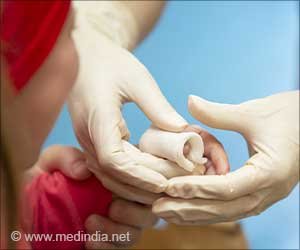E-bandage Could Aid in Wound Healing

The bandage also actively monitors the healing process and subsequently dissolves into the body, electrodes, and all, when no longer needed. The novel technology could be a useful tool for diabetic patients, whose ulcers can lead to a variety of consequences, including amputation of limbs or even death.
The findings were reported in the journal Science Advances. It is the first example of a smart regenerative system and the first bioresorbable bandage capable of administering electrotherapy.
Advertisement
“When a person develops a wound, the goal is always to close that wound as quickly as possible,” said Northwestern’s Guillermo A. Ameer, who co-led the study. “Otherwise, an open wound is susceptible to infection.” And, for people with diabetes, infections are even harder to treat and more dangerous. For these patients, there is a major unmet need for cost-effective solutions that really work for them. “Our new bandage is cost-effective, easy to apply, adaptable, comfortable, and efficient at closing wounds to prevent infections and further complications.”
“Although it’s an electronic device, the active components that interface with the wound bed are entirely resorbable,” said Northwestern’s John A. Rogers, who co-led the study. “As such, the materials disappear naturally after the healing process is complete, thereby avoiding any damage to the tissue that could otherwise be caused by physical extraction.”
Ameer is the Daniel Hale Williams professor of Biomedical Engineering at Northwestern’s McCormick School of Engineering and a professor of surgery at Northwestern’s Feinberg School of Medicine. He also oversees the National Institutes of Health-funded Center for Advanced Regeneration Engineering (CARE) and the predoctoral Regenerative Engineering Training Program. At McCormick and Feinberg, Rogers is the Louis Simpson and Kimberly Querrey professor of Materials Science and Engineering, Biomedical Engineering, and Neurological Surgery. He also serves as the director of the Querrey Simpson Institute for Bioelectronics.
Electricity’s Power
Diabetes affects almost 30 million people in the United States, with 15 to 25% developing a diabetic foot ulcer at some point in their lives. Diabetes can induce nerve damage, resulting in numbness; therefore, diabetics may encounter a simple blister or minor cut that goes unreported and untreated. Because high glucose levels thicken capillary walls, blood circulation slows, making the healing of these wounds more difficult. It’s the perfect storm for a minor injury to turn into a life-threatening wound.
The researchers wanted to see if electrical stimulation therapy could aid in the healing of these difficult wounds. Injuries, according to Ameer, might alter the body’s regular electrical signals. It restores the body’s normal signals by using electrical stimulation and recruiting new cells to the wound bed.
“Our body relies on electrical signals to function,” Ameer said. “We tried to restore or promote a more normal electrical environment across the wound.” We observed that cells rapidly migrated into the wound and regenerated skin tissue in the area. “The new skin tissue included new blood vessels, and inflammation was subdued.”
Clinicians have traditionally employed electrotherapy to promote healing. Yet, the majority of that equipment consists of wired, unwieldy gadgets that can only be utilized in a hospital setting under supervision. Ameer collaborated with Rogers, a bioelectronics pioneer who first developed the concept of bioresorbable electronic medicine in 2018, to create a more comfortable product that could be worn around the clock at home.
Control Through Remote
Finally, the two researchers and their colleagues created a thin, flexible bandage that lightly wraps around the wounded site. The smart regenerative system has two electrodes on one side: a tiny, flower-shaped electrode that lies directly on top of the wound bed and a ring-shaped electrode that sits on healthy tissue to surround the entire wound. The device’s other side houses an energy-harvesting coil that powers the system as well as a near-field communication (NFC) system that wirelessly transports data in real-time.
Sensors that can assess how effectively the wound is healing were also integrated by the team. Physicians can track development by measuring the resistance of the electrical current flowing through the wound. The healing process is directly related to a progressive drop in current measurements. If the current remains high, doctors will realize that something is wrong.
Reference :
- Bioresorbable, wireless, and battery-free system for electrotherapy and impedance sensing at wound sites – (https:www.science.org/doi/10.1126/sciadv.ade4687)
Source: Medindia
Source link
#Ebandage #Aid #Wound #Healing



